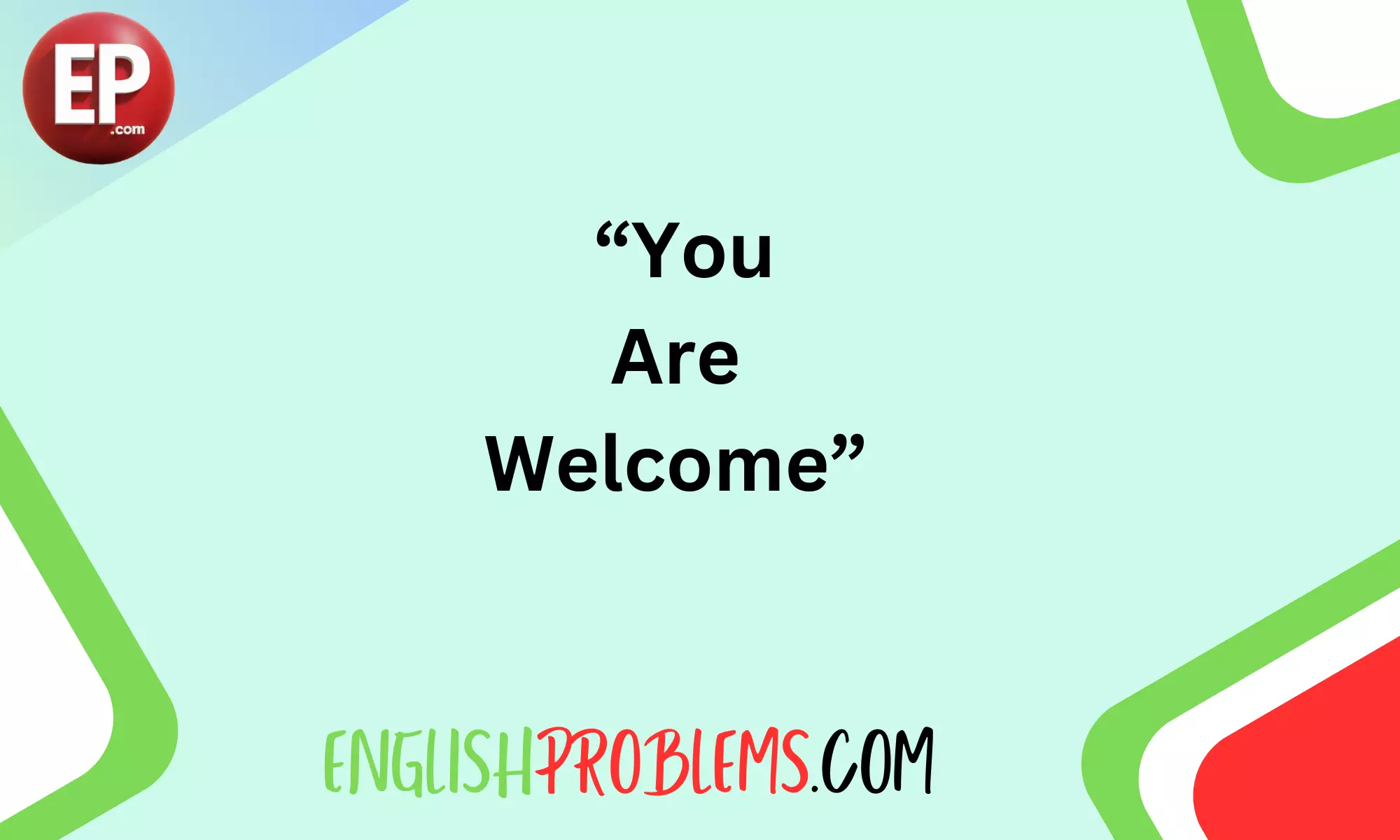In American English, knowing how to respond appropriately to gratitude is essential for clear and polite communication. The phrase “You are welcome” is a cornerstone of courteous interaction, yet its usage and nuances often perplex learners and even native speakers.
This guide delves into the depths of “You are welcome,” exploring its meanings, correct usage, and the subtleties that make it a vital part of everyday conversation.
Understanding the Basics of “You Are Welcome”
Historical Background of the Phrase
The phrase “You are welcome” has evolved over centuries. Its roots trace back to Old English, where “wilcuma” meant a desired guest or arrival. Over time, the phrase morphed into a polite response to expressions of thanks, embedding itself in the social fabric of English-speaking cultures.
Evolution in American English
In contemporary American English, “You are welcome” serves multiple functions. It’s not only a polite reply to “Thank you” but also a versatile expression used in various contexts. Understanding its historical and cultural journey helps appreciate its significance today.
What Does “Welcome” Really Mean?
Etymology and Definitions
The word “welcome” derives from the Old English “wilcuma,” a compound of “will” (pleasure) and “cuma” (guest). Essentially, it signified a person whose arrival brings pleasure. Today, its meanings have expanded:
- As an adjective: Meaning something that is gladly received.
- As a verb: To greet someone hospitably.
- As an interjection: Used to greet someone or express pleasure at their arrival.
Different Contexts
“Welcome” adapts to different contexts seamlessly. Here are a few examples:
- Adjective: “Your help was most welcome during the event.”
- Verb: “We welcome you to our home.”
- Interjection: “Welcome! Come in and make yourself comfortable.”
The Adjective Form of “Welcome”
Explanation and Examples
When used as an adjective, “welcome” describes something received with pleasure. Here are a few sentences illustrating its use:
- “Her presence was a welcome sight after such a long journey.”
- “The rain was a welcome relief during the drought.”
Nuances in Meaning and Usage
The adjective form often carries a nuance of relief or pleasure. It’s used to highlight the positive impact of the subject:
- Positive Reception: “Your ideas were very welcome during the meeting.”
- Relief: “The weekend is a welcome break after a hectic week.”
Common Mistakes and How to Avoid Them
Frequent Errors
Many learners mix up “you are welcome” with other forms, leading to confusion. Common mistakes include:
- Incorrect Usage: “You are welcomed.”
- Overly Formal: “You are most welcome” in casual settings.
Examples and Corrections
- Incorrect: “You are welcomed to the party.”
- Correct: “You are welcome to the party.”
- Incorrect: “Thank you for your help.” / “You are welcomed.”
- Correct: “Thank you for your help.” / “You are welcome.”
Tips to Avoid These Mistakes
- Context Matters: Use “You are welcome” as a response to “Thank you.”
- Keep It Simple: In casual settings, a simple “You’re welcome” suffices.
- Practice: Regular use in conversations helps cement the correct usage.
Exploring “Welcome” as a Verb
Functioning as a Verb
As a verb, “welcome” means to greet someone in a friendly manner or to receive something willingly.
- “They welcomed the new policy changes.”
- “We always welcome guests with open arms.”
Examples in Sentences
- “The committee welcomed the new member enthusiastically.”
- “The company welcomed feedback from its customers.”
Differences from Other Forms
- As a Verb: Involves action, e.g., “We welcome your input.”
- As an Adjective: Descriptive, e.g., “Your input is welcome.”
“You Are Welcome” vs. “You Are Welcomed” in Different Contexts
Proper Usage
Understanding the distinction between “You are welcome” and “You are welcomed” is crucial:
- You are welcome: A polite response to “Thank you.”
- You are welcomed: Indicates that someone was greeted warmly upon arrival.
Contextual Examples
- Polite Response: “Thank you for helping.” / “You are welcome.”
- Greeting: “You are welcomed at our annual meeting.”
Situational Guide
- Formal Events: “You are welcomed to the gala.”
- Everyday Use: “You’re welcome” after someone says “Thank you.”
When to Use “Welcome” as an Interjection
Definition and Examples
As an interjection, “welcome” expresses joy at someone’s arrival:
- “Welcome! We’ve been expecting you.”
- “Welcome to the team!”
Appropriate Situations
Use it when greeting guests or newcomers warmly. It’s often the first word spoken to convey immediate acceptance and pleasure.
Impact of Tone and Emphasis
Tone plays a significant role in how “welcome” is perceived. A warm, enthusiastic tone conveys genuine pleasure, while a flat tone might seem insincere.
Responding to “Thank You”: “You’re Welcome”
Cultural Significance
In American culture, acknowledging gratitude with a polite response like “You’re welcome” is a social norm. It maintains the flow of politeness and respect in conversations.
Variations and Alternatives
- “No problem.”
- “My pleasure.”
- “Don’t mention it.”
Impact on Social Interactions
Responding correctly fosters positive interactions and reinforces politeness. It shows that the speaker values the gratitude expressed.
Shades of Politeness in “You Are Welcome”
How Tone and Context Affect Politeness
Politeness varies with tone and context. A sincere “You’re welcome” is different from a casual “No problem.”
Different Levels of Formality
- Formal: “You are most welcome.”
- Casual: “You bet!”
Comparing “You’re Welcome” with Other Responses
- More Polite: “It’s my pleasure.”
- Less Formal: “Sure thing!”
Adding Empathy with “You Are More Than Welcome”
Enhanced Politeness
Saying “You are more than welcome” adds a layer of empathy and warmth. It emphasizes that the action was done with genuine care and without hesitation.
Examples and Contexts
- “You’re more than welcome to join us for dinner.”
- “You are more than welcome to use my car if you need it.”
Psychological Impact
Using this phrase can make the recipient feel valued and appreciated, fostering a stronger personal connection.
The Role of Tone in Expressing Sincerity
Intonation and Emphasis
How you say “You are welcome” can change its perceived sincerity. A heartfelt tone conveys genuine gratitude.
Examples of Sincere vs. Insincere Usage
- Sincere: “You’re very welcome!” (Warm and genuine)
- Insincere: “You’re welcome.” (Flat and uninterested)
Practice Tips for Expressing Sincerity
- Smile: A smile can enhance the warmth of your words.
- Eye Contact: Maintaining eye contact conveys sincerity.
- Voice Modulation: Varying your pitch and volume can emphasize your genuine intent.
Real-World Examples: “Welcome” vs. “Welcomed” in Published Works
Analysis in Literature and Media
Published works often provide clear examples of the correct usage of “welcome” and “welcomed.” Here are some notable instances:
- Books: “The guests were warmly welcomed by the host.”
- Articles: “Welcome to the annual charity event.”
Common Patterns and Trends
- Formal Writing: Prefers “welcomed” for describing greetings.
- Informal Writing: Commonly uses “welcome” in various forms.
Lessons from Published Examples
Analyzing these examples helps understand the contextual nuances and ensures accurate usage in your writing.
Conclusion
Mastering the phrase “You are welcome” involves understanding its various forms, contexts, and nuances. By exploring its historical background, grammatical functions, and practical applications, you can enhance your communication skills and ensure polite, effective interactions. Remember, the key to using “You are welcome” correctly lies in practicing and paying attention to tone, context, and sincerity.

Mia Evans brings a love for language and a knack for clarity to EnglishProblems.com. Her engaging writing style and expert knowledge help readers navigate the tricky terrain of English grammar with confidence and ease.










